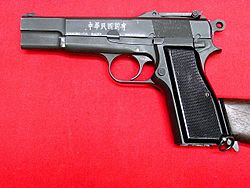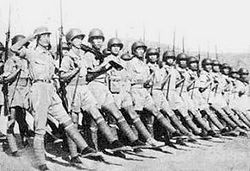- National Revolutionary Army
-
National Revolutionary Army (NRA)
國民革命軍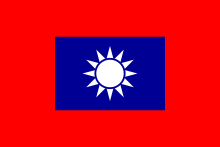
Flag of the National Revolutionary ArmyActive 1925–1947 Country Republic of China Allegiance Kuomintang (KMT)
Republic of China (ROC)Type Army Engagements Northern Expedition
Long March
Second Sino-Japanese War
Chinese Civil WarCommanders Notable
commandersChiang Kai-shek
Zhang Xueliang
Yen Hsi-shan
Feng Yuxiang
Sun Li-jen
He Yingqin
Hu Kexian
and many othersThe National Revolutionary Army (NRA) (traditional Chinese: 國民革命軍; simplified Chinese: 国民革命军; pinyin: Guómín Gémìng Jūn; Wade–Giles: Kuo-min Ke-ming Chün), pre-1928 sometimes shortened to 革命軍 or Revolutionary Army and between 1928-1947 as 國軍 or National Army was the Military Arm of the Kuomintang (KMT) from 1925 until 1947, as well as the national army of the Republic of China during the KMT's period of party rule beginning in 1928.
Originally organized with Soviet aid as a means for the KMT to unify China against warlordism, the National Revolutionary Army fought major engagements in the Northern Expedition against the Chinese Beiyang Army warlords, in the Second Sino-Japanese War against the Imperial Japanese Army, and in the Chinese Civil War against the People's Liberation Army.
During the Second Sino-Japanese War, the armed forces of the Communist Party of China were nominally incorporated into the National Revolutionary Army (while retaining separate commands), but broke away to form the People's Liberation Army shortly after the end of the war. With the promulgation of the Constitution of the Republic of China in 1947 and the formal end of the KMT party-state, the National Revolutionary Army was renamed the Republic of China Armed Forces (中華民國國軍), with the bulk of its forces forming the Republic of China Army, which retreated to Taiwan in 1949.
Contents
History
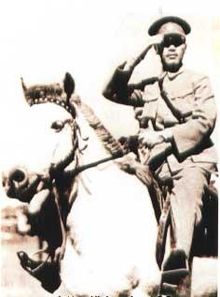 Generalissimo Chiang Kai-shek, Commander-in-Chief of the National Revolutionary Army, emerged from the Northern Expedition as the leader of China.
Generalissimo Chiang Kai-shek, Commander-in-Chief of the National Revolutionary Army, emerged from the Northern Expedition as the leader of China.
The NRA was founded by the Kuomintang in 1925 as the military force destined to unite China in the Northern Expedition. Organized with the help of the Comintern and guided under the doctrine of the Three Principles of the People, the distinction among party, state, and army was often blurred. A large number of the Army's officers passed through the Whampoa Military Academy, and the first commandant, Chiang Kai-shek, became commander-in-chief of the Army in 1925 before launching the successful Northern Expedition. Aside from Chiang Kai-shek himself, other prominent commanders in the National Revolutionary Army included Du Yuming and Chen Cheng.
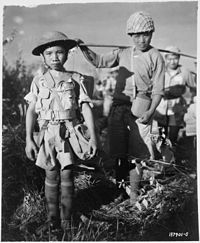 A Chinese Nationalist soldier, age 10, member of a Chinese division from the X Force, boarding planes in Burma bound for China, May 1944.
A Chinese Nationalist soldier, age 10, member of a Chinese division from the X Force, boarding planes in Burma bound for China, May 1944.
For a time, during the Second Sino-Japanese War, Communist forces fought as a nominal part of the National Revolutionary Army, forming the Eighth Route Army and the New Fourth Army units, but this co-operation later fell apart. Throughout the Chinese Civil War, the National Revolutionary Army experienced problems with desertion, with many troops switching sides to fight for the Communists. After the drafting and implementation of the Constitution of the Republic of China in 1947, the National Revolutionary Army was renamed as the Republic of China Armed Forces.[citation needed]
Organization
 The National Revolutionary Army soldiers marched into the British concessions in Hankou during the Northern Expedition.
The National Revolutionary Army soldiers marched into the British concessions in Hankou during the Northern Expedition.
The NRA throughout its lifespan recruited approximately 4,300,000 regulars, in 370 Standard Divisions (正式師), 46 New Divisions (新編師), 12 Cavalry Divisions (騎兵師), eight New Cavalry Divisions (新編騎兵師), 66 Temporary Divisions (暫編師), and 13 Reserve Divisions (預備師), for a grand total of 515 divisions. However, many divisions were formed from two or more other divisions, and were not active at the same time.
Also, New Divisions were created to replace Standard Divisions lost early in the war and were issued the old division's number. Therefore the number of divisions in active service at any given time is much smaller than this. The average NRA division had 5,000–6,000 troops; an average army had 10,000–15,000 troops, the equivalent of a Japanese division. Not even the German-trained divisions were on par in terms of manpower with a German or Japanese division, having only 10,000 men.
The NRA only had small number of armoured vehicles and mechanised troops. At the beginning of the war in 1937 the armour were organized in three Armoured Battalions, equipped with tanks and armoured cars from various countries. After these battalions were mostly destroyed in the Battle of Shanghai and Battle of Nanjing new tanks, armoured cars and trucks from the Soviet Union and Italy made it possible to create the only mechanized division in the army, the 200th Division. This Division eventually ceased to be a mechanized unit after the June 1938 reorganization of Divisions. The armoured and artillery Regiments were placed under direct command of 5th Corps and the 200th Division became a motorized Infantry Division within the same Corps. This Corps fought battles in Guangxi in 1939–1940 and in Burma in 1942 reducing the armored units due to losses and mechanical breakdown of the vehicles. On paper China had 3.8 million men under arms in 1941. They were organized into 246 "front-line" divisions, with another 70 divisions assigned to rear areas. Perhaps as many as forty Chinese divisions had been equipped with European-manufactured weapons and trained by foreign, particularly German and Soviet, advisers. The rest of the units were under strength and generally untrained. Overall, the Nationalist Army impressed most Western military observers as more reminiscent of a nineteenth- than a twentieth-century army.[1]
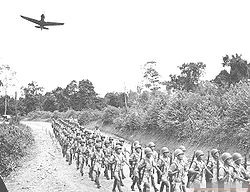 A group of NRA soldiers from Sun Li-jen's New First Army marching off while a P-40 Warhawk flies overhead. Notice the soldiers are wearing American M1 Helmets.
A group of NRA soldiers from Sun Li-jen's New First Army marching off while a P-40 Warhawk flies overhead. Notice the soldiers are wearing American M1 Helmets.
Late in the Burma Campaign the NRA Army there had an armoured battalion equipped with Sherman tanks.
Despite the poor views given by European observers on the European trained Divisions, the Muslim Divisions of the National Revolutionary Army, trained in China, not by westerners, and led by the Ma Clique Muslim Generals, frightened the European observers with their appearance and fighting skills in battle. Europeans like Sven Hedin and Georg Vasel were in awe of the appearance Chinese Muslim NRA divisions and their ferocious combat abilities. They were trained in harsh, brutal conditions.[2][3][4][5] The 36th Division (National Revolutionary Army), trained entirely in China, without any European help, was composed of Chinese Muslims, fought against and severely mauled an invading Soviet Russian army during the Soviet Invasion of Xinjiang. The division was inferior in technology and manpower, but slammed the superior Russian force.
The Muslim divisions of the army controlled by Muslim General Ma Hongkui were reported by western observers to be tough and disciplined. Despite having diabetes, Ma Hongkui personally drilled with his troops, and engaged in sword fencing during training.[6]
The NRA absorved massive amounts of warlord and provincial armies after their leaders joined the Kuomintang and were appointed as officers and Generals. These armies were renamed as NRA divisions, the Ninghai Army under Muslim Ma Clique General Ma Qi was renamed the National Revolutionary Army 26th Division after General Ma joined the Kuomintang. The entire Ma Clique armies were absorbed into the NRA and renamed as NRA divisions as well as other military forces.
Unit organization
The unit organisation of the NRA is as follows: (Note that a unit is not necessarily subordinate to one immediately above it; several army regiments can be found under an army group, for example.)
- Military Region ×12 (軍區)
- Army Corps ×4(兵團)
- Army Group ×40 (集團軍 Group Army)
- Route Army (路軍)
- Army ×30 (軍)
- Army Group ×40 (集團軍 Group Army)
- Army Corps ×4(兵團)
Commander-in-chief
- Generalissimo Chiang Kai-shek 1925–1947
Equipment
See also: Development of Chinese armoured forces (1927-1945), Development of Chinese Nationalist air force (1937–1945), and List of World War II firearms of ChinaChinese weapons were mainly produced for the National Revolutionary Army in the Hanyang, Guangdong and Taiyuan Arsenals.
For regular Chinese divisions their standard rifles were the Hanyang 88 (copy of Gewehr 88) and Chiang Kai-Shek rifle (copy of Mauser Standard Model). However, for most of the German-trained divisions, the standard firearms were German-made 7.92 mm Gewehr 98 and Karabiner 98k. The standard light machine gun was a local copy of the Czech 7.92 mm Brno ZB26. There were also Belgian and French light machine guns. Surprisingly, the NRA did not purchase any Maschinengewehr 34s from Germany, but did produce their own copies of them. On average in these divisions, there was one light machine gun set for each platoon. Heavy machine guns were mainly locally-made Type 24 water-cooled Maxim guns, which is the Chinese copy of the German MG08. On average every battalion would get one heavy machine gun (about a third to half of what actual German divisions got during World War II). The standard sidearm was the 7.63 mm Mauser C96 semi-automatic pistol, or full-automatic Mauser M1932/M712 machine pistol. These full-automatic versions were used as substitutes for submachine guns (such as the MP18) and rifles that were in short supply within the Chinese army prior to the end of World War II. Throughout the Second Sino-Japanese War, particularly in the early years, the NRA also extensively used captured Japanese weapons and equipment as their own were in short supply. Some élite units also used Lend-Lease US equipment as the war progressed.
Major Chinese Arsenals:
Province Arsenal Name Kwangtung Guangdong Arsenal Honan Kung Hsien Arsenal Manchuria Mukden Arsenal Hupei Hangyang Arsenal Shansi Taiyuan Arsenal Szechwan Chengtu Arsenal Some divisions were equipped with 37 mm PaK 35/36 anti-tank guns, and/or mortars from Oerlikon, Madsen, and Solothurn. Each infantry division had 6 French Brandt 81 mm mortars and 6 Solothurn 20 mm autocannons. Some independent brigades and artillery regiments were equipped with Bofors 72 mm L/14, or Krupp 72 mm L/29 mountain guns and there were 24 Rheinmetall 150 mm L/32 sFH 18 howitzers (bought in 1934) and 24 Krupp 150 mm L/30 sFH 18 howitzers (bought in 1936). At the start of the war, the NRA and the Tax Police Regiment had three tank battalions armed with German Panzer I light tanks and CV-33 tankettes. After defeat in the Battle of Shanghai the remaining tanks, together with several hundred T-26 and BT-5 tanks acquired from the Soviet Union were reorganised into the 200th Division.
Infantry uniforms were basically redesigned Zhongshan suits. Puttees were standard for soldiers and officers alike since the primary mode of movement for NRA troops was by foot. The helmets were the most distinguishing characteristic of these divisions. From the moment German M35 helmets (standard issue for the Wehrmacht until late in the European theatre) rolled off the production lines in 1935, and until 1936, the NRA imported 315,000 of these helmets, each with the Blue Sky with a White Sun emblem of the ROC on the sides. Other helmets include the Adrian helmet, Brodie helmet and later M1 helmet. Other equipment included cloth shoes for soldiers, leather shoes for officers and leather boots for high-ranking officers. Every soldier was issued ammunition, ammunition pouch or harness, a water flask, combat knives, food bag, and a gas mask.
Spears and swords in addition to rifles were used by the Muslim Ma Clique sections of the National Revolutionary Army.[6] The Muslims had an assortment of rifles, German, British, Russian, and others.
Gallery
-
Sun Yat-sen [middle behind the table] and Chiang Kai-shek [on stage in uniform] at the founding of the Whampoa Military Academy in 1924.
-
The cavalry of the National Revolutionary Army charging with Dadaos. One of them has what appears to be a pistol.
-
National Revolutionary Army soldiers manning a Czech ZB vz. 26 Light Machine Gun. Note the Blue-Sky White Sun insignia on the Brodie helmets.
-
Generalissimo Chiang Kai-shek inspecting cadets of the Whampoa Military Academy.
-
National Revolutionary army soldiers wearing the M35 Stahlhelm in a parade.
-
German-trained Nationalist Soldiers Marching with Gewehr 98 rifles.
Foreign suppliers
 Belgium
Belgium Canada
Canada Czechoslovakia
Czechoslovakia Denmark
Denmark France
France Germany
Germany Italy
Italy Soviet Union
Soviet Union Sweden
Sweden United Kingdom
United Kingdom United States
United States
See also
- German-trained divisions of the National Revolutionary Army
- Whampoa Military Academy
- Warlord era
- Chiang Kai-shek
- Sino-German cooperation
- Kuomintang
- Republic of China Armed Forces
- History of the Republic of China
- People's Liberation Army
- Chinese Air Force
- Chinese Army in India
- Chinese Expeditionary Force (in Burma)
- Republic of China Navy
References
- ^ p.5 http://www.history.army.mil/brochures/72-38/72-38.htm
- ^ Andrew D. W. Forbes (1986). Warlords and Muslims in Chinese Central Asia: a political history of Republican Sinkiang 1911-1949. Cambridge, England: CUP Archive. p. 97. ISBN 0521255147. http://books.google.com/books?id=IAs9AAAAIAAJ&pg=PA97&lpg=PA97&dq=sven+hedin+ma+chung-ying&source=bl&ots=KziGbXektN&sig=zvle_1dkzNnOTGb7rgxp4Xhf_wo&hl=en&ei=FGdTTMzhB4GB8gbc_aTEBA&sa=X&oi=book_result&ct=result&resnum=7&ved=0CCoQ6AEwBg#v=onepage&q=sven%20hedin%20ma%20chung-ying&f=false. Retrieved 2010-06-28.
- ^ Andrew D. W. Forbes (1986). Warlords and Muslims in Chinese Central Asia: a political history of Republican Sinkiang 1911-1949. CUP Archive. p. 120. ISBN 0521255147. http://books.google.com/books?id=IAs9AAAAIAAJ&pg=PA120&dq=soviet+GPU+troops&hl=en&ei=QuwWTLPEMoX7lwfu_pTjCw&sa=X&oi=book_result&ct=result&resnum=1&ved=0CCsQ6AEwAA#v=onepage&q=tanks%20planes%20artillery%20sword&f=false. Retrieved 2010-06-28.
- ^ Christian Tyler (2004). Wild West China: the taming of Xinjiang. New Brunswick, New Jersey: Rutgers University Press. p. 109. ISBN 0813535336. http://books.google.com/books?id=bEzNwgtiVQ0C&pg=PA109&dq=ma+zhongying+parallel+bars&hl=en&ei=UXkaTJ3WBIXwNIPDyJ0F&sa=X&oi=book_result&ct=result&resnum=1&ved=0CDMQ6AEwAA#v=onepage&q=shadow-fencing%20parallel%20bars&f=false. Retrieved 2010-06-28.
- ^ Andrew D. W. Forbes (1986). Warlords and Muslims in Chinese Central Asia: a political history of Republican Sinkiang 1911-1949. CUP Archive. p. 107. ISBN 0521255147. http://books.google.com/books?id=IAs9AAAAIAAJ&printsec=frontcover&dq=warlords+and+muslims&hl=en&ei=XoyOTLbsGMaqlAe83aTJAg&sa=X&oi=book_result&ct=result&resnum=1&ved=0CCkQ6AEwAA#v=onepage&q=brown%20mass%20human&f=false. Retrieved 2010-06-28.
- ^ a b LIFE Nov 1, 1948 Ma Hung-Kwei
External links
Categories:- Military of the Republic of China
- Military units and formations established in 1925
- Military wings of political parties
- National Revolutionary Army
- Military Region ×12 (軍區)
Wikimedia Foundation. 2010.


